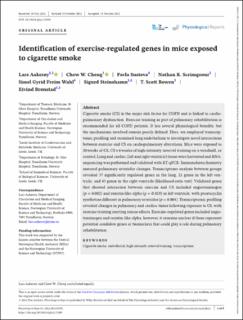| dc.contributor.author | Aakerøy, Lars | |
| dc.contributor.author | Cheng, Chew W. | |
| dc.contributor.author | Sustova, Pavla | |
| dc.contributor.author | Scrimgeour, Nathan Robert | |
| dc.contributor.author | Wahl, Sissel Gyrid Freim | |
| dc.contributor.author | Steinshamn, Sigurd Loe | |
| dc.contributor.author | Bowen, T Scott | |
| dc.contributor.author | Brønstad, Eivind | |
| dc.date.accessioned | 2023-01-18T12:30:51Z | |
| dc.date.available | 2023-01-18T12:30:51Z | |
| dc.date.created | 2022-11-19T14:23:09Z | |
| dc.date.issued | 2022 | |
| dc.identifier.citation | Physiological Reports. 2022, 10 (21), | en_US |
| dc.identifier.issn | 2051-817X | |
| dc.identifier.uri | https://hdl.handle.net/11250/3044303 | |
| dc.description.abstract | Cigarette smoke (CS) is the major risk factor for COPD and is linked to cardiopulmonary dysfunction. Exercise training as part of pulmonary rehabilitation is recommended for all COPD patients. It has several physiological benefits, but the mechanisms involved remain poorly defined. Here, we employed transcriptomic profiling and examined lung endothelium to investigate novel interactions between exercise and CS on cardiopulmonary alterations. Mice were exposed to 20 weeks of CS, CS + 6 weeks of high-intensity interval training on a treadmill, or control. Lung and cardiac (left and right ventricle) tissue were harvested and RNA-sequencing was performed and validated with RT-qPCR. Immunohistochemistry assessed pulmonary arteriolar changes. Transcriptome analysis between groups revealed 37 significantly regulated genes in the lung, 21 genes in the left ventricle, and 43 genes in the right ventricle (likelihood-ratio test). Validated genes that showed interaction between exercise and CS included angiotensinogen (p = 0.002) and resistin-like alpha (p = 0.019) in left ventricle, with prostacyclin synthetase different in pulmonary arterioles (p = 0.004). Transcriptomic profiling revealed changes in pulmonary and cardiac tissue following exposure to CS, with exercise training exerting rescue effects. Exercise-regulated genes included angiotensinogen and resistin-like alpha, however, it remains unclear if these represent potential candidate genes or biomarkers that could play a role during pulmonary rehabilitation. | en_US |
| dc.language.iso | eng | en_US |
| dc.publisher | Wiley Periodicals LLC on behalf of The Physiological Society and the American Physiological Society. | en_US |
| dc.rights | Navngivelse 4.0 Internasjonal | * |
| dc.rights.uri | http://creativecommons.org/licenses/by/4.0/deed.no | * |
| dc.title | Identification of exercise-regulated genes in mice exposed to cigarette smoke | en_US |
| dc.title.alternative | Identification of exercise-regulated genes in mice exposed to cigarette smoke | en_US |
| dc.type | Peer reviewed | en_US |
| dc.type | Journal article | en_US |
| dc.description.version | publishedVersion | en_US |
| dc.source.volume | 10 | en_US |
| dc.source.journal | Physiological Reports | en_US |
| dc.source.issue | 21 | en_US |
| dc.identifier.doi | 10.14814/phy2.15505 | |
| dc.identifier.cristin | 2076736 | |
| cristin.ispublished | true | |
| cristin.fulltext | original | |
| cristin.qualitycode | 1 | |

